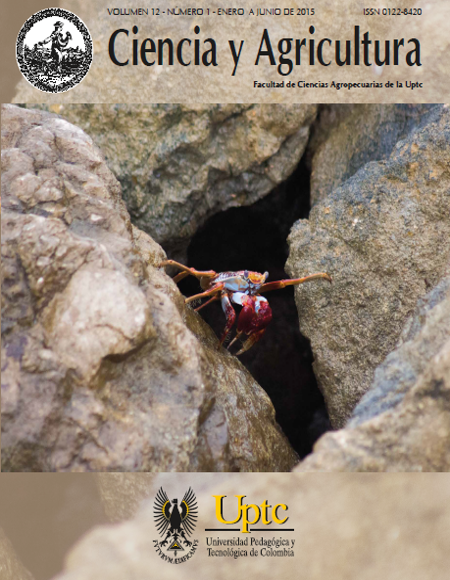Sustancias húmicas en la disminución del estrés en gallinas ponedoras durante la fase posmuda

Resumen
Una de las prácticas productivas en gallinas ponedoras que causa polémica es la muda forzada, debido al estrés nutricional al que son sometidas durante este período. Esta investigación evaluó el efecto de las sustancias húmicas (SH) en los indicadores de estrés durante la fase de posmuda. Se utilizaron 120 gallinas ponedoras Hy Line Brown, en los primeros 60 días de la posmuda, las cuales se dividieron en cuatro grupos: El primero y segundo grupo se suplementaron con 0,1 y 0,2% de SH, respectivamente, el tercer grupo se suplementó con 0,25 mg/kg de clorhidrato de levamisol, y el cuarto grupo no recibió suplementación.
Se tomaron muestras sanguíneas los días 8,30 y 60, para evaluar hematocritos y relación heterófilos/linfocitos (H/L), y se registró la inmovilidad tónica (IT) los días 30 y 60.Se evidenció que los días 30 y 60, los grupos suplementados con SH incrementaron la concentración de hematocrito y disminuyeron la relación H/L y el tiempo de IT (p<,0,05). Los resultados obtenidos indican que las SH provenientes de la biotransformación de cachaza, hojas y vinaza de la producción de azúcar se comportan como agentes mitigadores de estrés en la fase temprana y media de la posmuda en gallinas ponedoras Hy Line Brown.
Palabras clave
Bienestar animal, Gallinas ponedoras, Estrés nutricional, Muda forzada, Sustancias húmicas
Citas
- El-Deek A & Al-harthi M. Post molt performance parameters of broiler breeder hens associated with molt induced by feed restriction, high dietary zinc and fasting. Int J of Poult. Sci.2004; 3(7): 456-462.
- Alodan M., Mashaly M. Effect and induced molting in laying hens on production and immune parameters. Poult.Sci. 1999; 78: 171-177.
- Hassanien H. Effect of force molting programs on egg production and quality of laying hens. Asian JofPoult. Sci. 2011; 5(1): 13-20.
- Tega E., Ibrahim T. Effect of induced molting on fertility and hatchability chickens. Continental J. Animal and Vet Res. 2010; 2: 31-34.
- Akram M., Zia-ur-rahman C., Kim S. Effect on the induced molting on the relative weights and hormone levels of thyroid, ovary and adrenal glands in spent laying hens. Korean J InternMedPoult. Sci. 2002; 29: 243-247.
- Shini S, Kaiser P, Shini A, Bryden W. Biological response of chickens (Gallus gallusdomesticus) induced by corticosterone and a bacterial
- endotoxin. Comp BiochemPhys,part B, 2008; 149: 324-333.
- Sandoval G, Terraes J, Revidatti F. Fernández R, Gauna C, Martín G. Hematocrito, relación heterófilo linfocito e inmovilidad tónica en pollos con estrés psico-fisico crónico criados en jaulas. Comunicaciones científicas y tecnológicas, 2003; 026: 1-3.
- Eren M., Gezen S., Deniz G., Orhan F. Effects of liquid humate supplemented to drinking water on the performance and egg shell quality of hens in different laying periods. Revue. Med vet. 2008; 159(2): 91-95.
- Ergin O., Ocak N., Turan A., Erener G., Altop A. Performance, Carcass, gastrointestinal tract and meat quality traits and selected blood parameters of broilers fed diets supplemented with humicsubstances. J. Sci. Food Agr.2011; 92: 59-65.
- Sanmiguel R, Rondón I. Suplementación con sustancias húmicas en gallinas ponedoras durante la fase postmuda.Rev Ces MedZootec. 2014; 9(2): 169-178.
- Hy Line International. 2011. Manual de estándares de rendimiento.
- Abo Egla E., El-Samra H., Ismail F., Abd-El ghany F., Assar M. Effect of humic acid and BIOMOS supplementation on egg production and quality parameters in local hens.J.Anim Poult Prod. 2011; 2(4): 55-63.
- Yoruk M, Gul M, Hayirly A, Macit M. The effects of supplementation of humate and probiotics on egg production and quality parameters during the late laying period in hens. Poult.Sci. 2004; 83: 84-88.
- Elrom. Handling and transportation of broilers - welfare, stress, fear and meat quality. Part III: fear; definitions, its relation to stress, causes of fear, responses of fear and measurement of fear. Israel J VetMed, 2000; 55: 3.
- Tejeda A, Téllez I, Galindo F. Técnicas de medición de estrés en aves. Vet Mex,1997; 28(4): 345-351.
- Campos y Dávila. Changes in heterophil to lymphocyte ratios of heat-stressed chickens in response to dietary supplementation of several related stress agents. Arch. Geflu¨gelk, 2002; 66(2): 80-84.
- Ajakaiye J., Ayo J., Ojo S. Effect of heat stress on some blood parameters and egg production of shika brown layer chickens transported by road. Biol Res. 2010; 43: 183-189.
- Rath N., Huff W., Huff G. Effects of humic acid on broiler chickens. Poult.Sci. 2010;85: 410-414.
- Van Rensburg J., Van Rensburg C., Van Rissen J. In vitro and in vivo assessment of humic acid as an aflatoxinbinder in broiler chickens. Poult. Sci. 2006; 5: 1576-1583.
- Krams I, VrublevskaJ,Cirule D,Kivleniece I, Krama T. Aeterophil/lymphocyte ratios predict the magnitude of humoral immune response to a novel antigen in great tits (Parus major). Comp Biochem Phys. Part A 2012; 161: 422-428.
- Campos y Dávila. Effect of Photoperiod on Heterophil to Lymphocyte Ratio and Tonic Immobility Duration of Chickens.Poult.Sci. 2002; 81:1637-1639.